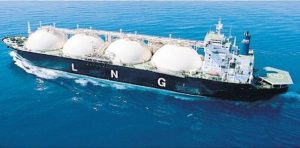In the oil and gas industry, oil has been a dominant energy commodity in the world as a fuel or as a feed stock to refineries for building up a country’s economy. The imbalance between the oil production and consumption determine the transportation routes by pipeline or oil tankers. Oil Pipelines are the most efficient method of transporting oil, but only oil tankers could deliver oil to anywhere as required, across the world.
Natural Gas is another principal source of energy which is normally transported through pipeline to specific locations. With development of natural gas liquefaction technology, natural gas could be cooled to -162 degC and turned to liquid phase with only 1/600 of its original volume. The product commonly known as LNG, liquefied natural gas, could be delivered to any location worldwide, by a special vessel, LNG cargo. Different from oil tanker, LNG cargo is an insulated vessel which keeps the LNG in its liquid phase at -162 deg C. A typical LNG cargo is shown in Figure 1.

Figure 1: LNG Cargo, reproduced from website
The intense fossil fuel consumption in the world causes a trajectory long-term temperature increase above the internationally agreed 1.5- 2˚C target by end of this century. A low carbon transition strategy must be implemented for each country to reduce GHG emissions. Natural gas is the lowest carbon energy with less GHG emission and air pollution compared to other fossil fuels. With the increasing trend of high population and urbanization rates, more natural gas would be needed for sustainable survival on this planet. Natural gas, either by pipeline or by LNG cargo, needs to be delivered to the worldwide market.
Figure 2 shows the major natural gas trade movements in 2016. LNG from South America, Africa, Middle East, Australia, South East Asia and Russia were delivered to Europe and Northeastern Asian market.

Figure 2:Global Natural Gas Trade [BP Statistical Review of World Energy, 2017]
With shale gas revolution in North America, Natural gas supply in the U.S. was changed from scarcity to abundance. Seven LNG import terminals were switched to become LNG export terminals since 2008. The U.S. started LNG export in early 2016, and soon became a net exporter of gas, by April 2017!
With more stringent environmental pressure and higher energy demand in the world, especially in Asian market, more of natural gas will be needed to fuel each country’s economic growth. LNG, the liquefied natural gas, has transformed natural gas from being a regional commodity to a global one, thus opening the possibility of trading and delivering in markets worldwide, irrespective of geopolitical constraints!
Authored by: Maggie Han
Maggie Han is currently working in Shell as process engineer. She has a wide experience in oil and gas industry, globally, and her work experience spans about 20 years with major players like Shell,BP and Sinopec, China.
